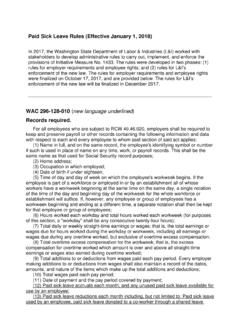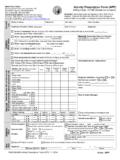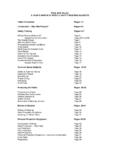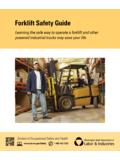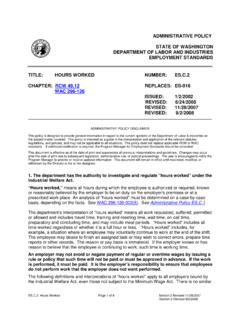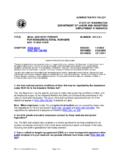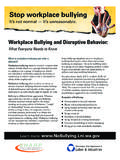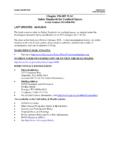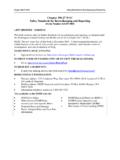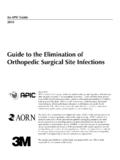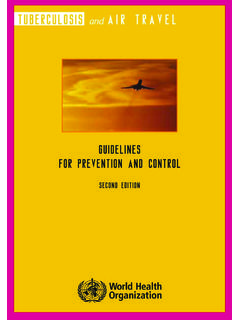Transcription of Hazards to Truck Drivers and other Workers while …
1 FATAL FACTS. Hazards to Truck Drivers and other Workers while Loading and Unloading Trucks and Trailers Loading and unloading materials, goods, and products from trucks are daily activities in many businesses. These activities are also a regular and frequent source of workplace injuries and fatalities. In Washington State from years 2005-2010: 12 workplace fatalities occurred during Truck loading or unloading. Six of the 12 incidents involved machinery including forklifts and cranes. Five incidents involved Truck Drivers , 3 involved laborers, 2 involved supervisors, 1 involved a landscaper and 1 involved a crane operator. Some of the incidents that happened during Truck loading and unloading in Washington State are described here: On January 15, 2010, a freight operations supervisor was assisting a forklift driver secure freight on a storage rack inside a trailer. The supervisor reached up and grabbed a piece of freight to steady himself when the 500 lb. pallet of freight shifted and fell on him.
2 On June 25, 2007, a Truck driver was unloading a delivery of a 2-ton manufactured piece of steel. He was standing beside the Truck unfastening a securing strap when the piece of steel, which was improperly secured, fell off the Truck and crushed him. On March 24, 2006, three Workers were securing a load on the deck of a boom Truck . The load came in contact with the levers of the boom crane, causing it to elevate and come into contact with an overhead high voltage power line. One worker was electrocuted. The other two received severe electrical shocks and were hospitalized. On December 6, 2005, a Truck driver was picking up waste drums of cooking oil at a restaurant. He was using the Truck 's hydraulic lift gate to lift the drums when he was crushed between the Truck 's bed and the lift gate. HOW TO PREVENT Truck LOADING AND UNLOADING INCIDENTS. Restrict personnel on foot from the loading zone during operations. Train loaders and Drivers to identify Hazards and apply safe work practices.
3 Secure loads on trucks, forklifts and cranes properly. Establish procedures to assure Workers are clear of trailers/wheels before moving. Release date: January 20, 2011. Report #: 47-20-2011. How can these Fatal Facts be used? The purpose of this Fatal Facts is to alert people to the Hazards of Truck loading/unloading and to prevent future deaths when performing these jobs. The first page of this report can be posted on a bulletin board. The additional pages describe the recommendations in further detail and provide resource contacts. On the left is a breakdown of fatal incidents for years 2005-2010 and on the right is a breakdown by incident characteristics. 3 100. Percent of Fatalities Load/Unload Fatalities 80. 2. 60. 40. 1. 20. 0 0. 2005 2006 2007 2008 2009 2010 Loading Truck Drivers Machinery Logging Year Involved Operations How can these deaths be prevented? These fatalities point to many of the Hazards and help to identify many of the situations and risks encountered daily by Workers loading and unloading material and equipment.
4 These fatalities and serious injuries while loading and unloading trucks are preventable by following recommended procedures and the use of proper equipment. Additional Controls for Prevention Protect all gaps and drop-offs on loading docks and lift gates. Assure appropriate forklift and machinery equipment and training. Never be downhill of a moving load. Implement safer sheeting and tarping equipment or procedures. Use wheel chocks and other vehicle restraint devices. See other resources for Hazards specific to logging trucks like Fatal Facts: Logging Fatalities 1998 to 2008. Tips for Employers Employers have a responsibility to ensure the safety of their trucks, Drivers and other Workers . Here are some suggestions for establishing safe work procedures. 1. Analyze company injury data to determine where and how injuries are happening. Target your safety program to address these problems. 2. Establish safe procedures for all types of loading and unloading. 3. Train all Workers involved in the operations or in the area of loading and unloading.
5 Refresher training, periodic toolbox talks, or information sheets can help provide reinforcement. 4. Supervise Workers and provide feedback for proper and improper procedures. 5. Maintain vehicles and equipment in safe operating condition. Failure of straps or anything securing a load can result in an incident. Communication between maintenance and management should occur regularly. 6. Conduct regular safety meetings that include management and other representatives. 7. Address macho attitudes or hasty work habits that may lead to unsafe conditions for people around trucks. 8. Encourage Workers to report Hazards encountered on the job. Primary Hazard Controls All personnel on foot must be clear of the loading Institute procedures to assure people are clear of zone during all mechanized loading or unloading trucks and trailers before moving operations Companies should have procedures in place to make Material and equipment can shift or break free during sure that any Truck , trailer or container being moved is any location transfer.
6 Empty of all personnel and all Workers on-foot are clear . Workers on foot should never be on the opposite side Drivers should visually inspect and secure any Truck or of a Truck from a forklift while it is loading or unloading trailer and the area around it before moving it to material. assure all Workers are clear . Do not allow Workers on foot in trailers while a forklift is A visual sign indicating Workers are in a trailer should involved in loading/unloading operations. be visible from the Truck mirrors anytime personnel are Provide Drivers a place to wait away from the Truck . working in or on a Truck at a loading dock. Truck keys may be placed on a board by the loader Identify Hazards before loading or unloading during operations and returned to the driver once All personnel involved with a loading or unloading completed. operation should assess the potential Hazards before the operation begins. A clear understanding of the Protect all drop-offs, gaps, and pinch points on procedures and communication between Workers must loading docks and lift gates be established.
7 All loading docks should be equipped with dock-plates Site and freight specific knowledge is important. and physical barriers around any gaps that present fall Avoid overhead power lines or steep grades. Hazards to Workers or equipment. Use dock levelers to Visiting Drivers should be made aware of their provide safe access to trailers. When using a hydraulic responsibilities. lift gate, block or avoid gaps and pinch points or install a safety trip bar. Document and enforce standard operating procedures Assure appropriate forklift and machinery Proper loading and unloading procedures should be equipment and training established by the company. Forklift and machinery operators are responsible for the safety of ground personnel at the site as well as All Workers in the loading zones should be trained on themselves. Operators must be trained on safe these safe work practices and given refresher trainings periodically. operation of the equipment, load limits, loading procedures, and communication with other personnel.
8 Corrections and enforcement of company procedures, if necessary, should be carried out for any observed Never be downhill of a moving load hazardous deviations in procedure. Personnel should never be downhill of any load or cart being moved. Heavy or unstable loads or equipment Properly secure loads on trucks, forklifts and cranes failure could cause a cart or lift to move downhill and All loads must be secured to the Truck , container, or crush others. Care should be taken by equipment trailer to prevent shifting of material and equipment operators and by all personnel on-site to avoid locations during transport. Equipment such as load bars, vertical that place them below a moving load. supports, and load straps should be used to assure that the load arrives in the same orientation as when it Use wheel chocks and other vehicle restraint departed. devices All vehicles should be parked with a fully operational Follow correct procedures any time a load is raised parking brake engaged during loading and unloading.
9 And transferred Wheel chocks should be used in addition to the brake, During transfer of any load, all personnel must stay particularly if any slope is present. clear of the path of travel. When moving multiple items or loads that may shift, Wear a High Visibility Vest properly secure them with straps, bands or other Truck Drivers should wear a high visibility vest whenever means. they exit their vehicle at their company yard or dock, a When raising and moving loads with a boom or crane, customer delivery site, or on the side of the road. All ensure that the path of travel is clear of Hazards . personnel working around moving vehicles and mechanized equipment during loading and unloading Implement safer sheeting and tarping equipment or operations should wear a high visibility vest. procedures Securing loads with tarps and sheeting presents a frequent hazard to Drivers and other Workers . Implement procedures or mechanical tarping/sheeting systems to assure Workers are not exposed to Hazards that increase the likelihood of an incident.
10 Logging Trucks Require Specific Attention other Resources Many serious injuries and fatalities occur while loading and unloading logs. A separate Trucking Injury Reduction Emphasis (TIRES). Washington FACE report details logging Truck Hazards . Please refer to Logging Fatalities 1998 to 2008, for detailed recommendations specific to OSHA loading / unloading resources logging trucks. Forklift Safety and Injury/Fatality Prevention Safety Standards Powered Industrial Trucks: WAC 296-863. tm Safety Standards Logging Operations: WAC. 296-54. Getting Help FACE Fatal Facts L&I Consultation Program Washington State Produced by the Washington State Fatality Department of Labor and Industries Assessment & Control Evaluation (FACE) Program sultation Everett (Region 1, Northwest Washington) Managed by the SHARP Program 425-290-1300 Washington Department of Labor & Industries Seattle (Region 2, King County) PO Box 44330. Olympia, WA 98504-4330. 206-515-2800. 360-902-5669 or 1-888-667-4277 (toll-free).

